Unit1Whatsthematter教案
- 格式:doc
- 大小:130.00 KB
- 文档页数:17
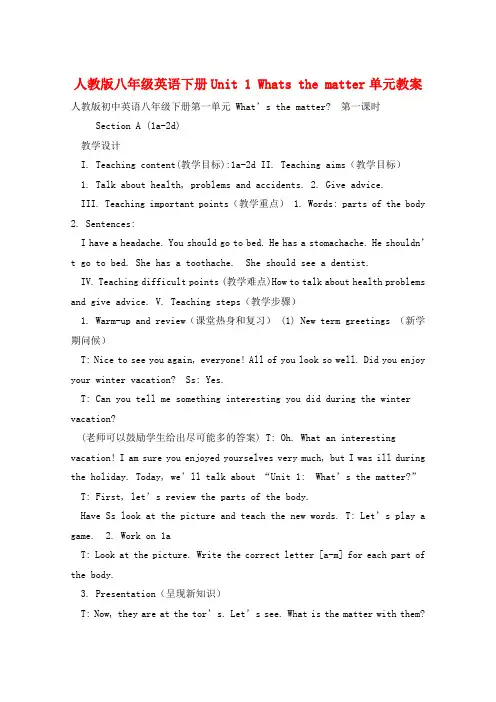
人教版八年级英语下册Unit 1 Whats the matter单元教案人教版初中英语八年级下册第一单元 What’s the matter? 第一课时Section A (1a-2d)教学设计I. Teaching content(教学目标):1a-2d II. Teaching aims(教学目标)1. Talk about health, problems and accidents.2. Give advice.III. Teaching important points(教学重点) 1. Words: parts of the body2. Sentences:I have a headache. You should go to bed. He has a stomachache. He shouldn’t go to bed. She has a toothache. She should see a dentist.IV. Teaching difficult points (教学难点)How to talk about health problems and give advice. V. Teaching steps(教学步骤)1. Warm-up and review(课堂热身和复习) (1) New term greetings (新学期问候)T: Nice to see you again, everyone! All of you look so well. Did you enjoy your winter vacation? Ss: Yes.T: Can you tell me something interesting you did during the winter vacation?(老师可以鼓励学生给出尽可能多的答案) T: Oh. What an interesting vacation! I am sure you enjoyed yourselves very much, but I was ill during the holiday. Today, we’ll talk about “Unit 1: W hat’s the mat ter?” T: First, let’s review the parts of the body.Have Ss look at the picture and teach the new words. T: Let’s play a game. 2. Work on 1aT: Look at the picture. Write the correct letter [a-m] for each part of the body.3. Presentation(呈现新知识)T: Now, they are at the tor’s. Let’s see. What is the matter with them?We can also ask, What’s wrong with them? T: (help Ss answer) He has a cold.1T: What should he do?T: He should take some medicine.教师用同样的方法教授其他疾病及相关的建议:1. 胃/肚子疼2. 脖子疼3 头疼4. 嗓子疼, 喉咙疼5. 背疼 6. 感冒7. 发高/低烧 8.咳嗽9.牙痛 4. Work on 1cPresent the picture and have Ss to do the pair work. 总结各种疾病及如何给出建议和句型。
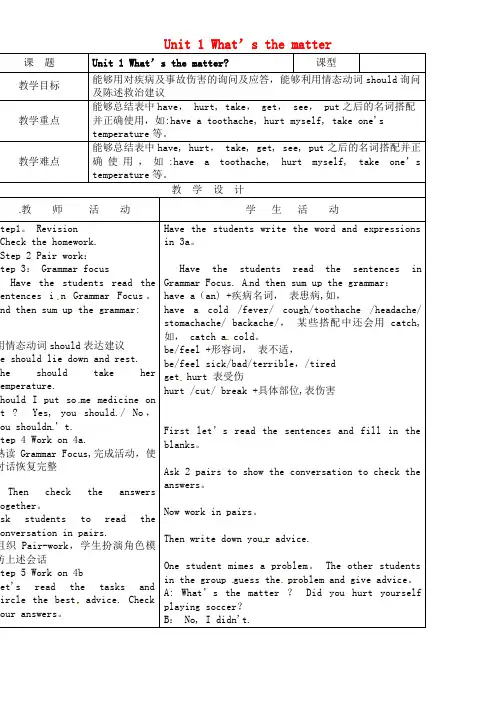
教师活动Step1。
RevisionCheck the homework.Step 2 Pair work:Step 3: Grammar focusHave the students read the sentences i n Grammar Focus。
And then sum up the grammar:用情态动词should表达建议He should lie down and rest. She should take her temperature.Should I put so me medicine on it ? Yes, you should./ No,you shouldn’t.Step 4 Work on 4a.熟读Grammar Focus,完成活动,使对话恢复完整Then check the answers together。
Ask students to read the conversation in pairs.组织Pair-work,学生扮演角色模仿上述会话Step 5 Work on 4bLet's read the tasks and circle the best advice. Check your answers。
Have the students write the word and expressions in 3a。
Have the students read the sentences in Grammar Focus. A nd then sum up the grammar:have a(an) +疾病名词,表患病,如,have a cold /fever/ cough/toothache /headache/ stomachache/ backache/,某些搭配中还会用catch, 如, catch a cold。
be/feel +形容词,表不适,be/feel sick/bad/terrible,/tiredget hurt 表受伤hurt /cut/ break +具体部位,表伤害First let’s read the sentences and fill in the blanks。
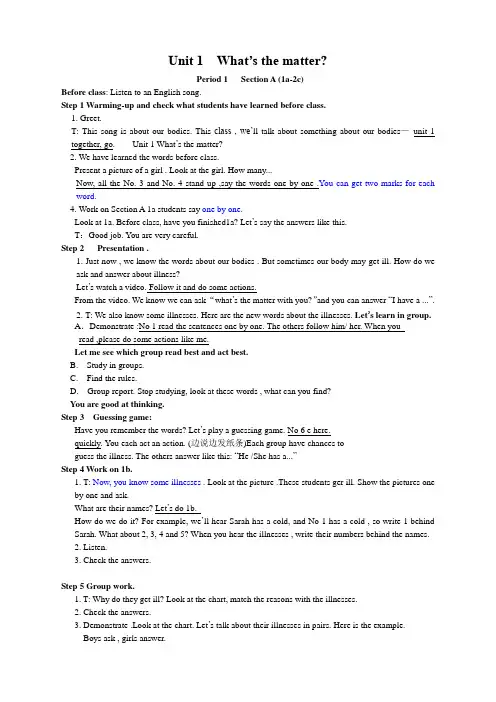
Unit 1 What’s the matter?Period 1 Section A (1a-2c)Before class: Listen to an English song.Step 1 Warming-up and check what students have learned before class.1. Greet.T: This song is about our bodies. This class , we’ll talk about something about our bodies—unit 1 together, go. Unit 1 What’s the matter?2. We have learned the words before class.Present a picture of a girl . Look at the girl. How many...Now, all the No. 3 and No. 4 stand up ,say the words one by one .You can get two marks for each word.4. Work on Section A 1a students say one by one.Look at 1a. Before class, have you finished1a? Let’s say the answers like this.T:Good job. You are very careful.Step 2 Presentation .1. Just now , we know the words about our bodies . But sometimes our body may get ill. How do weask and answer about illness?Let’s watch a video. Follow it and do some actions.From the video. We know we can ask “what’s the matter with you?”and you can answer “I have a ...”.2.T: We also know some illnesses. Here are the new words about the illnesses. Let’s learn in group.A.Demonstrate :No 1 read the sentences one by one. The others follow him/ her. When youread ,please do some actions like me.Let me see which group read best and act best.B. Study in groups.C. Find the rules.D. Group report. Stop studying, look at these words , what can you find?You are good at thinking.Step 3 Guessing game:Have you remember the words? Let’s play a guessing game. No 6 e here.quickly. You each act an action. (边说边发纸条)Each group have chances toguess the illness. The others answer like this: “He /She has a...”Step 4 Work on 1b.1. T: Now, you know some illnesses . Look at the picture .These students ger ill. Show the pictures oneby one and ask.What are their names? Let’s do 1b.How do we do it? For example, we’ll hear Sarah has a cold, and No 1 has a cold , so write 1 behind Sarah. What about 2, 3, 4 and 5? When you hear the illnesses , write their numbers behind the names.2. Listen.3. Check the answers.Step 5 Group work.1. T: Why do they get ill? Look at the chart, match the reasons with the illnesses.2. Check the answers.3. Demonstrate .Look at the chart. Let’s talk about their illnesses in pairs. Here is the example.Boys ask , girls answer.4. Look at the chart and make more similar conversations.When you talk , please talk loudly, correctly and politely, please do some actions and use the nice intonations.5. Let students show their conversations.Step 6 Work on 2a and 2b.1. T: David has a stomachache, what should he do?Show the pictures ,ask and answer. 板书What should …do? …should….T: Your advice is very useful. Let’s learn more advice from 2a and 2b.2. Listen, finish 2a. What’s the matter with the people? What advice do they get?3. First , guess the answers to 2b. Then listen and check the answers.OK, you have good listening skills.Step 7 Group work.The advice for illness is very useful . It can help us take good care of ourselves and others.T: If some students are ill, will you give some advice and help them? let’s act andmake conversations. Let me see who is the kind person? How do we talk?Look at the example.2. Show the example.When you talk , please talk loudly, correctly and politely, please do some actions and use the nice intonations.3. Students work.4. Let students show their conversations.Step 8 Summarize and homework:Period 2 Section A 2d,Grammar Knowledge aims:1. The students will be able to learn the words and phrases: take breaks, hurt,2.Summarize the grammar and practice them.3. Target Language:①What’s the matter with Ben? –He hurt himself./ He has a sore back.②-Do you have a fever? -Yes, I do./ No, I don’t.③-Does he have a toothache? -Yes, he does.④You shouldn’t eat so much next time.⑤What should she do?⑥She should take her temperature.⑦-Should I put some medicine on it? -Yes, you should. / No, you shouldn’t.Structure: ①“should/ shouldn’t + verb” for suggestion ②Reflexive pronouns. Ability Object:1.Enable students to talk more about health.2.Learn to give others some advice according to their matters.3.Enable the students to do things using the target language and the grammar.Emotion Object:1.Learn to live in a healthy way.2. Learn to take care of others and themselves.Teaching Key Points:1. How to teach the Ss to learn the names of the illness: toothache, fever and headache.2. How to give others some advice according to their matters.3. The grammar.Teaching Difficult Points:1.How to give advice using should.2. Use the grammar to do things.Teaching Procedures:Step 1 Review.1. Free-talk. What ‘s the weather like today? If you don’t wear warm clothes, what willhappen?2.Show the pictures and say.He / She has_______________. He /She should___________.Step 2 Work on 2d.1. Game.Do in the same way2. Listen to the conversation and answer my questions .1). What's the matter with Lisa?2). What did Lisa do on the weekend?3). What should Lisa do ?3. Role-play the conversation.First, have students to role-play the conversation in 2d in groups and choose the best. Step 3 Group work.1. Give more examples. Have students read the conversation in 4c.2. and then ask them to work in groups. One student mimes a problem. The otherstudents in his/ her group guess the problem and give their advice.Step 4 Grammar Focus .Have students to read and remember the sentences of Grammar Focus by themselves, and then have them work in groups to sum up how to talk about health problems and give right advice.Step5 Work on 4a.Ask students to go through each conversation in 4a quickly, and then plete the conversations individually. Move around the classroom and help them if necessary.Check the answers.Ask some students to practice every conversation in pairs.Step 6 Work on 4b.Have students choose and circle best advice for the health problems in 4b. Then ask students add their own advice about these health problems.Have some students to report their own advice in class.Step 7 Summary.Health problems and give right advice.Ask one or two students to sum up the key phrases in the passage, and help them to make up more sentences with them.Step 8 Homework .Have students make up conversations to talk about sb.’s health problems and give them some advice.Period 3 Section A 3aKnowledge aims:The students will be able to learn the words and phrases: passenger, get off, to one’s surprise, onto, trouble, hit, right away, get into.2.The students will be able to use the expressions:The driver didn’t think about thinking about himself. He only thought about saving a life.Ability aims:The students can understand the passage.2.To train the students’ cooperation with their partners.Emotional aims:To train the students to care about others and help others who are on trouble..Teaching important points:The students can understand the passage and use the useful expressions freely.Teaching difficult points:The students can learn from the drivers and do as the driver does if possible.Teaching procedures:Step 1 Warming-up and lead-in.1. Watch a video.2. What is the short sketch about?3.Look at the picture. What can you see? Can you guess what is happening?Step 2 Preparing reading.1. Guess the main idea.What is this passage mainly about?Strategy : The title and pictures can be helpful to understand the text.Title may be the main meaning of the article.2. Read the passage. Do you think it es from a newspaper or a book?Step 3 While-reading.1.Find the topic sentence(中心句)of each paragraph.1). At 9:00 a.m. yesterday, bus No. 26 was going along Zhanghua Road when the driver saw an oldman lying on the side of the road.2). Some passengers helped Mr. Wang to move the man onto the bus.3). Thanks to Mr. Wang and the passengers, the doctors saved the man in time.2. Which sentences touched you? Read them in the way that you like.Step 4 Post-reading.1. Praise the persons.What a great person the driver was!He stopped the bus without thinking twice, when he saw an old man lying on the side of the road.What _______ the _____ was/were!2. Work on 3bAfter checkin answers, have Ss scan the passage and check (√) the things that happened in the story.3. Work on 3c.T: Ask the students to discuss the questions in pairs.Step5 Homework.1. If you are the driver, write a diary about what happened yesterday.2. If you are the passenger, write a diary about what happened yesterday.3. Act the story out in your group.4. Read some messages about good men.Period 4 Section B 1a-1dStep 1 Lead –in and learn the new words.It’s a beautiful song, I like it very much. Let’s learn the new words.1. Who can be the teacher? One student teach one word.2. Let’s sing and remember the new words.The teacher teaches to sing, ask some group to sing. Finally sing together.(可以课前教唱,。
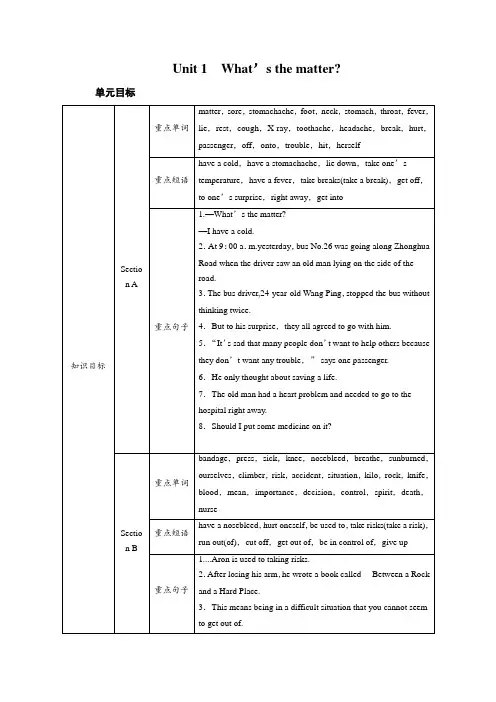
Unit 1What’s the matter?单元目标1....Aron is used to taking risks.2.After losing his arm,he wrote a book called Between a Rockand a Hard Place.3.This means being in a difficult situation that you cannot seemto get out of.第一课时Section A(1a-2d) 课时目标自主学习根据句意及音标提示写出单词及其汉语意思。
1.What’s the matter /’mætə(r)/?问题;事情2.I have a stomachache /’stʌməkeɪk/.胃痛;腹痛3.She has a fever /’fiːvə(r)/.发烧4.You need to take a break /breɪk/.间歇;休息教学过程环节1新课导入The teacher shows the pictures about body parts on the slide.(用幻灯片展示身体部位的图片)T:Look at the screen and speak it out in Chinese.(教师展示眼睛的图片)Ss:眼睛。
T:Eye.E-Y-E,eye.Repeat it 3 times.Ss :Eye,eye,eye.Then the teacher writes “eye” on the blackboard.Let the students speak it out loudly and spell it in the air with fingers.Study other words of body parts like this.设计意图:通过展示身体部位的图片及提问,创设出比较活泼轻松的学习氛围,激发学生的学习热情,同时提前感知有关身体部位的单词,为下面的教学做好铺垫。
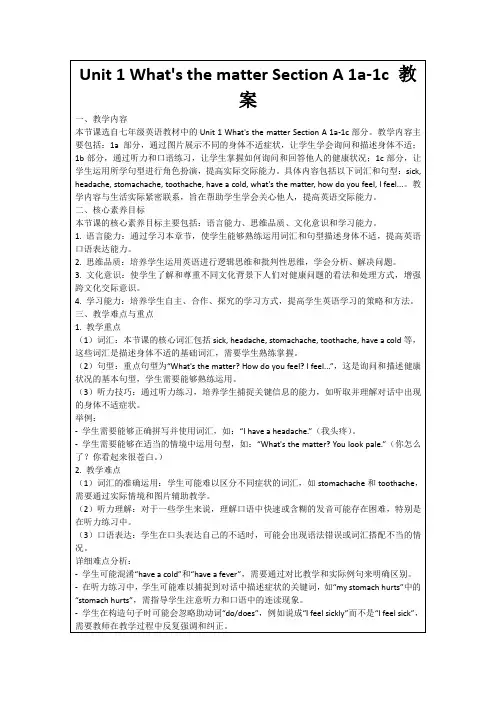
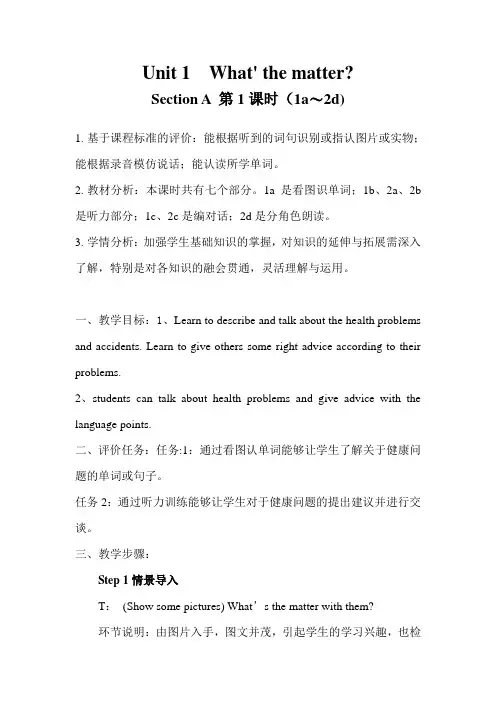
Unit 1 What' the matter?Section A 第1课时(1a〜2d)1.基于课程标准的评价:能根据听到的词句识别或指认图片或实物;能根据录音模仿说话;能认读所学单词。
2.教材分析:本课时共有七个部分。
1a是看图识单词;1b、2a、2b 是听力部分;1c、2c是编对话;2d是分角色朗读。
3.学情分析:加强学生基础知识的掌握,对知识的延伸与拓展需深入了解,特别是对各知识的融会贯通,灵活理解与运用。
一、教学目标:1、Learn to describe and talk about the health problems and accidents. Learn to give others some right advice according to their problems.2、students can talk about health problems and give advice with the language points.二、评价任务:任务:1:通过看图认单词能够让学生了解关于健康问题的单词或句子。
任务2:通过听力训练能够让学生对于健康问题的提出建议并进行交谈。
三、教学步骤:Step 1情景导入T:(Show some pictures) What’s the matter with them?环节说明:由图片入手,图文并茂,引起学生的学习兴趣,也检查学生的预习情况。
Step 2 完成教材1a—1c的任务1. 学生朗读la中的单词,教师纠正错误读音,然后学生识记单词并将单词和身体部位匹配。
2. 让学生仔细观察la图片中的人物,然后认真听录音,完成课本上lb的听力任务并跟读。
3. 结对练习lc中的对话,并请一些学生表演他们的对话。
环节说明:听说结合,向学生传达语言目标,通过结对对话练习,使语言目标得以强化。
Step 3 完成教材2a—2d的任务1. 认真观察2a图片,按听到的对话顺序给图片标号,集体核对答案。
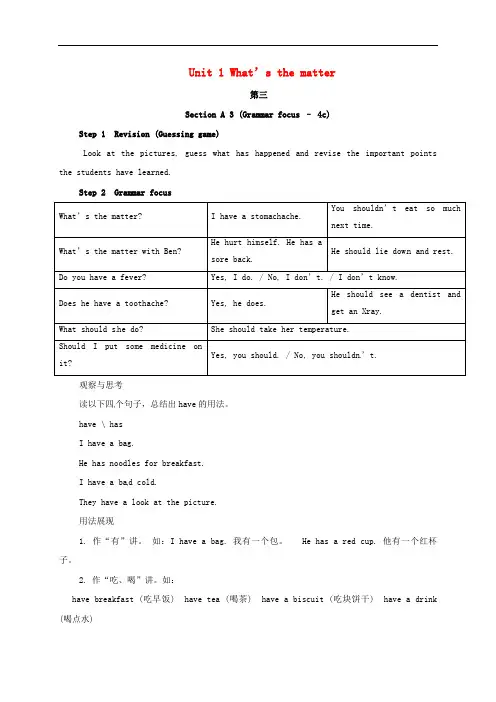
Unit 1 What’s the matter第三Section A 3 (Grammar focus – 4c)Step 1 Revision (Guessing game)Look at the pictures, guess what has happened and revise the important points the students have learned.Step 2 Grammar focusWhat’s the matter? I have a stomachache. You shouldn’t eat so much next time.What’s the matter with Ben?He hurt himself. He has asore back.He should lie dow n and rest.Do you have a fever? Yes, I do. / No, I don’t. / I don’t know.Does he have a toothache? Yes, he does. He should see a dentist and get an Xray.What should s he do? She should take her temperature.Should I put some medicine onit?Yes, you should. / No, you shouldn’t.观察与思考读以下四个句子,总结出have的用法。
have \ hasI have a bag.He has noodles for breakfast.I have a ba d cold.They have a look at the picture.用法展现1. 作“有”讲。
如:I have a bag. 我有一个包。
He has a red cup. 他有一个红杯子。
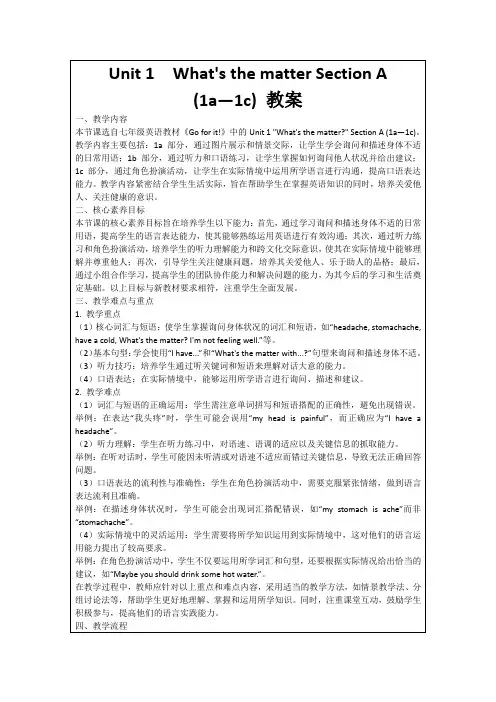
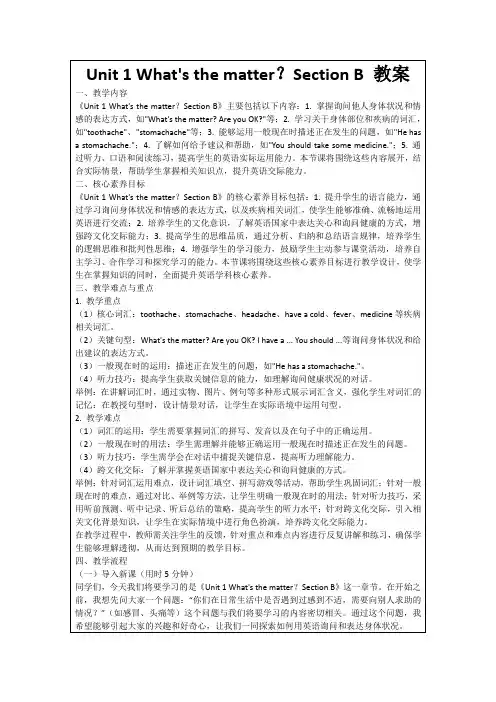
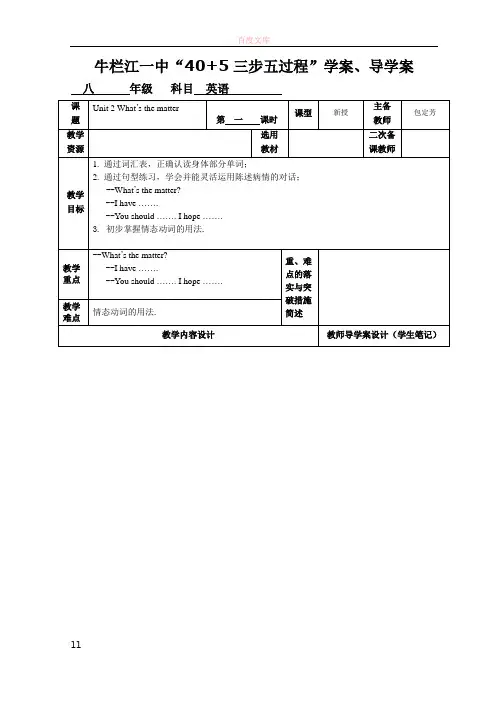
牛栏江一中“40+5三步五过程”学案、导学案八年级科目英语课题Unit 2 What’s the matter第一课时课型新授主备教师包定芳教学资源选用教材二次备课教师教学目标1. 通过词汇表,正确认读身体部分单词;2. 通过句型练习,学会并能灵活运用陈述病情的对话; --What’s the matter?--I have …….--You should ……. I hope …….3. 初步掌握情态动词的用法.教学重点--What’s the matter?--I have …….--You should ……. I hope …….重、难点的落实与突破措施简述教学难点情态动词的用法.教学内容设计教师导学案设计(学生笔记)学生预习一·预习指导·1. 快速背诵单词。
2.动作表演身体各个部分位。
·平行训练·按要求写出下列单词:1.牙痛_________ 2. 头痛_________ 3. 胃痛_________ 4.发烧____________5. mouth(复数)_________6. tooth(复数)_________7. foot(复数)__________教师学前导入自主探究二·自学指导·1. 听录音Section A 1b 完成练习;2. 快速背诵1c对话;3. 听录音Section A 2a & 2b 完成练习;4. 完成2c 内容。
·平行训练·1. What’s _____? I have a sore back.A. matterB. the matterC. the question2. I have sore eyes. You _____ go to see a doctor.A. shouldB. shouldn’tC. could3. She isn’t feeling _____. She wants to lie down and rest.A. wellB. goodC. terrible合作交流·合作探究·下面我们来看一组词,看看你能说出他们的规律吗?1. have a sore throat2. have a sore back3. have a sore knee同学们,现在我们可以用几种方式来表示病痛了呢?把它们分别记下来。
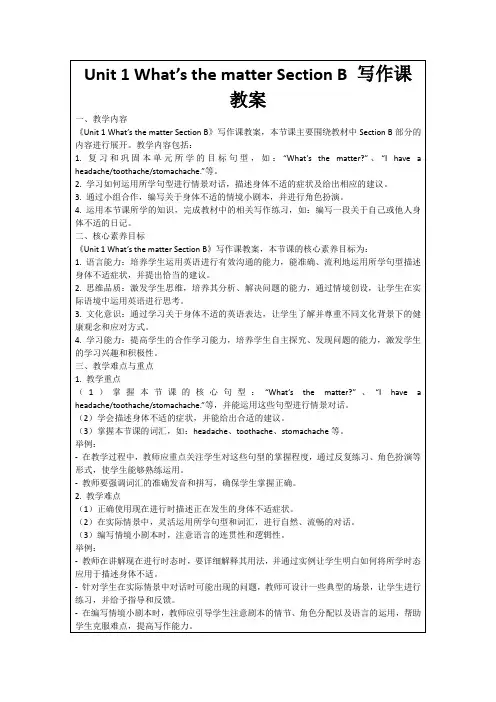
Unit 1 What is the matter?Period 1 Section A (1a-2d)一、教学目标:1. 语言知识目标1) 能掌握以下单词以及短语:matter, sore, have a cold, foot, neck, stomach,throat, fever, lie,lie down, rest, cough, toothache, headache, break, hurt, enough water, takebreaks away from, all weekend, take one’s temperature, in the same way,go to a doctor, see a dentist, get an X-ray, cut oneself.2) 能熟悉以下句型:What’s the matter with…?”“What should I/ you/ he/ she/they… do?”“I/ you/ he/ she/they should do…”2. 情感态度价值观目标:教会学生关心他人,培养同学间团结、友善的精神。
二、教学重难点1. 教学重点:掌握相关的单词和词组,并能够灵活运用。
会使用以下句型:“What’s the matter with…?”“What should I/ you/ he/ she/they…do?”“I/ you/ he/ she/they should do…”2. 教学难点:学生对听力材料中新句型、新词组的理解。
三、教学过程Step1 Greet the whole class as usual.T: What’s the date today?/ What day is it today?/ How’s the weather?/ How was your weekend?/What do you usually do on weekends?/ Do you like exercising?/ How often do you exercise?/ That’s great! To do exercise can keep us healthy, but if we don’t pay attention to our health, there will be something wrong with our body. Now , look at these people.Learn some new words.Step2 引入一般过去时,对上学期所学知识进行复习。
人教版八年级英语下册《Unit1 what’s the matter》说课稿(第3课时)一. 教材分析《Unit1 What’s the matter?》是人民教育出版社出版的八年级英语下册第三单元的主题句。
本节课主要讨论人们在不同情境下的感受和状况,通过学习本节课,学生能够掌握询问他人状况的交际用语,并学会用英语表达各种情感和身体状况。
教材内容丰富,贴近学生生活,有利于激发学生的学习兴趣。
二. 学情分析八年级的学生已经具备一定的英语基础,对于日常的交际用语有一定的了解。
但学生在表达复杂情感和身体状况时,往往会出现词汇和语法上的困难。
因此,在教学过程中,教师需要关注学生的个体差异,针对不同学生的学习需求进行引导和帮助。
三. 说教学目标1.知识目标:学生能够掌握并运用本节课的重点词汇和句型,如“What’s the matter?”, “How do you feel?”, “I have a headache.”等。
2.能力目标:学生能够用英语询问他人的状况,并能够表达自己的情感和身体状况。
3.情感目标:通过本节课的学习,学生能够学会关心他人,培养良好的情感交流能力。
四. 说教学重难点1.重点:本节课的重点是让学生掌握并运用询问他人状况的句型“What’s the matter?”以及表达情感和身体状况的词汇。
2.难点:学生在表达复杂情感和身体状况时,可能会出现词汇和语法上的困难,如如何正确使用情态动词和形容词等。
五. 说教学方法与手段本节课采用任务型教学法,通过设置各种情境,让学生在实际操作中学会运用英语询问和表达他人的状况。
同时,教师利用多媒体手段,如图片、视频等,帮助学生更好地理解和记忆词汇。
六. 说教学过程1.导入:教师通过展示一幅漫画,引导学生谈论漫画中人物的状况,引出本节课的主题。
2.新课呈现:教师通过播放一段视频,让学生观察视频中人物的表情和动作,引导学生学会用英语询问他人的状况。
1 / 17 Unit 1 What’s the matter? 教学目标: 1语言目标:描述健康问题的词汇,及如何根据别人的健康问题提建议。 2 技能目标:能听懂谈论健康问题的对话材料;能根据别人的健康问题提建议;能写出重点单词和重点句型,并能描述怎样对待健康问题。。 3 情感目标:通过开展扮演病人等活动,培养学生关心他人身体健康的品质。 通过本课的阅读,培养学生处理紧急事件的基本能力,树立紧急事件时互相帮助的精神。 教学重点: 短语: have a stomachache, have a cold, lie down, take one’s temperature, go to a doctor, get off, to one’s surprise, agree to do sth., get into trouble, fall down, be used to, run out (of), cut off , get out of, be in control of , keep on (doing sth.), give up 句子: 1 What’s the matter? I have a stomachache. You shouldn’t eat so much next time. 2 What’s the matter with Ben? He hurt himself. He has a sore back. He should lie down and rest. 3 Do you have a fever? Yes, I do. No, I don’t. I don’t know. 4 Does he have a toothache? Yes, he does. He should see a dentist and get an X-ray. 5 What should she do? She should take her temperature. 6 Should I put some medicine on it? Yes, you should No, you shouldn’t. 教学难点:掌握情态动词should \shouldn’t. 的用法 学习have的用法 课时划分: Section A1 1a – 2d Section A2 3a-3c Section A3 Grammar Focus-4c Section B1 1a-2e Section B2 3a-Self check
Section A 1 (1a – 2d) Step 1 Warming up and new words Look at a picture and learn the parts of the body. New words and phrases. Step 2 Presentation 1a Look at the picture. Write the correct letter [a-m] for each part of the body. ___arm ___ back ___ ear ___ eye ___ foot ___hand ___ head ___ leg ___ mouth ___ neck ___nose ___ stomach ___ tooth Step 3 Listening 1b Listen and look at the picture. Then number the names 1-5 Listen to the conversations again and fill in the blanks. 2 / 17
Conversation 1 Nurse: What’s the matter, Sarah? Girl: I ___________. Conversation 2 Nurse: What’s the matter, David? Boy: I _________________. Conversation 3 Nurse: What’s the matter, Ben? Boy: I _________________. Conversation 4 Nurse: What’s the matter, Nancy? Girl: I _________________. Conversation 5 Betty: What’s the matter, Judy? Ann: She __________________. Step 4 Speaking 1c Look at the pictures. What are the students’ problems? Make conversations. Examples A: What’s the matter with Judy? B: She talked too much yesterday and didn’t drink enough water. She has a very sore throat now. A: What’s the matter with Sarah? B: She didn’t take care of herself on the weekend. She was playing with her friends at the park yesterday. Then it got windy, but she didn’t put on her jacket. Now she has a cold. Step 5 Guessing games Guess what has happened to the students by using the important sentences. Step 6 Listening 2a Listen and number the pictures [1-5] in the order you hear them. 2b Listen again. Match the problems with the advice. Step 7 Speaking 2c Make conversations using the information in 2a and 2b A: What’s the matter? B: My head feels very hot. A: Maybe you have a fever. B: What should I do? A: You should take your temperature. Step 8 Role–play Imagine you are the school doctor. A few students have health problems. Role-play a conversation between the doctor and the students. 2d Role –play the conversation Step 9 Language points and summary 1. What’s the matter? 这是人们特别是医生和护士询问病人病情时最常用的问句, 意思是“怎么了?”其后通常与介词with连用。类似的问句还有: 3 / 17
What’s wrong? 怎么啦? What’s wrong with you? 你怎么了? What’s your trouble? 你怎么了? What’s the trouble with you? 你怎么了? What’s up? 你怎么了? 2. have a cold伤风, 感冒, 是固定词组 表示身体不适的常用词组还有: have a bad cold 重感冒 have a fever 发烧 have a headache 头痛 have a stomachache 肚子痛, 胃痛 have a toothache 牙痛 Summary 1. 牙疼 have a toothache 2. 胃疼 have a stomachache 3. 背疼 have a backache 4. 头疼 have a headache 5. 喉咙疼 have a sore throat 6. 发烧 have a fever 7. 感冒 have a cold 8. 躺下并且休息 lie down and rest 9. 喝热蜂蜜茶 drink hot tea with honey 10. 喝大量水 drink lots of water 11. 看牙医 see a dentist 12. 量体温 take one’s temperature 13. 看医生 go to a doctor Step 10 Exercises 根据上下文意思填空。 Mandy: Lisa, are you OK? Lisa: I _____ a headache and I can’t move my neck. What ______ I do? Should I _____ my temperature? Mandy: No, it doesn’t sound like you have a fever. What _____ you do on the weekend? Lisa: I played computer _____ all weekend. Mandy: That’s probably why. You need to take breaks _____ from the computer. Lisa: Yeah, I think I sat in the _____ way for too long without moving. Mandy: I think you should ____ down and rest. If your head and neck still hurt tomorrow, then go to a _______. Lisa: OK. Thanks, Mandy. 翻译下列句子。 1. 你怎么了?我头痛。 2. 他怎么了?他发烧 3. 李雷怎么了?他喉咙痛。他应该多喝水。 4. 如果你的头和脖子明天仍然疼的话,请去看医生。